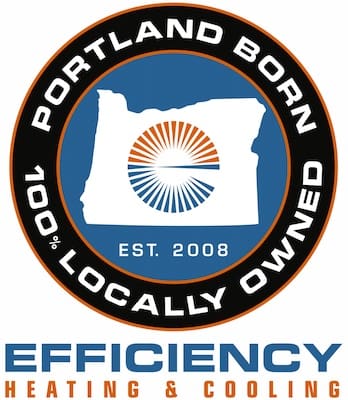To circulate cool air effectively in your Portland home, you need a combination of airflow, ventilation, and smart cooling habits. Start by setting your HVAC fan to Auto or On during hot days—this helps distribute cool air evenly. Use ceiling fans in a counterclockwise direction to push cool air downward. Make sure vents are fully open and not blocked by furniture or rugs, allowing unrestricted air movement throughout your rooms.
For multi-level homes, it helps to close basement vents slightly to push more cool air upstairs, where it tends to get hotter. You can also install duct boosters or zoned systems to control airflow in specific areas. In Portland, where the climate can shift between warm and breezy, opening windows at night can also help cool your home.
If you’re still experiencing uneven cooling, have your ducts inspected for leaks or blockages, and consider professional balancing to improve overall airflow and comfort.
Use Fans to Boost AC Circulation
Fans are one of the simplest ways to circulate cool air in a house. Ceiling fans should rotate counterclockwise in summer, pushing air downward. You can also use box fans or floor fans to redirect cool air from strong vents into warmer areas. Running a fan along with your AC reduces cooling time and spreads air more evenly throughout your home.
Adjust Vents and Returns for Balance
Make sure all vents and return air ducts are transparent and open. If vents are blocked by furniture or curtains, cool air gets trapped in one spot. You can also try partially closing vents in overly cold rooms to push more air into warmer zones. Balancing your vents improves circulation and prevents hot spots in your home.
Rearrange Furniture to Unblock Airflow
Sometimes, large furniture like sofas, bookshelves, or beds can unknowingly block vents or restrict airflow across the room. Rearranging furniture to allow unobstructed airflow improves circulation and helps every room cool more evenly. It’s a simple trick that makes a noticeable difference, especially in smaller Portland homes or apartments.
Use Floor Fans Strategically
Floor fans are great tools to push cool air from one room to another. Place them near strong vents or in doorways to guide airflow toward warmer zones. You can even set up a fan near a return vent to help draw warm air out more efficiently. Just a few fans placed correctly can cool down tough-to-reach areas fast.
Inspect Air Registers and Grilles
Dust, pet hair, and debris can build up on air registers and return grilles, restricting airflow. Cleaning them regularly helps your system work better and keeps the air moving freely. Use a vacuum and a damp cloth to clean them, and make sure the louvers are fully open for best results.
Optimize Your Thermostat Placement
If your thermostat is placed near a window, kitchen, or direct sunlight, it may read higher temperatures than the rest of the house. This causes the system to cycle inefficiently, throwing off circulation. Consider moving the thermostat to a central interior wall for more accurate temperature control and better airflow distribution.
Upgrade Your HVAC System if Needed
Older HVAC systems may struggle to circulate cool air effectively due to low blower capacity or outdated controls. If your unit is over 10–15 years old, it may be time to explore an upgrade. Newer systems offer variable-speed fans, zoning capabilities, and innovative airflow management—perfect for Portland homes with inconsistent cooling.
Create Cross-Ventilation at Night
Portland’s summer evenings are usually cooler. Take advantage by opening windows on opposite sides of your house to create cross-ventilation. Use a window fan to pull in cool air on one side and push out warm air on the other. This natural airflow can refresh your home and reduce your AC’s workload overnight.
More Information :
- Rooms Feel Stuffy or Smelly
- Hot Air Coming Out of Vents in Summer
- Inconsistent Temperatures Throughout the House
Resource Worth Checking:
According to ENERGY STAR’s cooling guidance, maximizing airflow with ceiling fans, zoning, and duct improvements can lower cooling costs by up to 15%.
Some Further Steps to Follow:
1. Keep Interior Doors Open
Keeping interior doors open allows air to move freely between rooms. When doors are closed, it can trap air in one space and prevent circulation. For homes with multiple vents and returns, open doors help maintain balanced pressure and temperature across the house.
2. Run Your HVAC Fan Between Cycles
Set your thermostat to run the fan on “auto” or “circulate” between cooling cycles. This keeps air moving even when the AC compressor isn’t running, which helps blend cool air throughout the home. This tip is constructive in split-level or multi-story homes in Portland.
3. Improve Insulation and Seal Leaks
Poor insulation or air leaks can cause cool air to escape before it reaches your living space. Check windows, doors, and ductwork for gaps, cracks, or damaged seals. Better insulation traps cool air inside, allowing your system to circulate it more effectively.
4. Install a Zoning System
A zoning system uses dampers and smart thermostats to control airflow to specific areas. If you have rooms that are always warmer or cooler, zoning can help redirect airflow to match each room’s needs. It’s an energy-efficient way to personalize comfort in every part of your home.
5. Schedule a Duct Inspection
If airflow feels weak or uneven, your ductwork might be dirty, leaky, or undersized. A professional HVAC tech can inspect the system and recommend cleaning, sealing, or resizing if needed. This helps your system move cool air where it’s needed most.
6. Consider a Ductless Mini-Split
For hard-to-cool spaces like sun rooms or garages, installing a ductless mini-split system can provide direct cooling and circulation without affecting the rest of your system. These systems are perfect for targeted airflow and zoning control.
7. Use Curtains and Blinds Wisely
During peak sun hours, close curtains or blinds to prevent heat from entering. Blocking solar gain keeps rooms cooler, allowing your AC to work more efficiently and making it easier to circulate the air. In the evening, open them again to release trapped heat.
FAQs
How do I make my house cool evenly?
Keep doors open, vents unblocked, and fans running to promote consistent airflow in all rooms.
What direction should ceiling fans spin in summer?
Ceiling fans should spin counterclockwise to push cool air down and improve circulation.
Should I run the HVAC fan all day?
Running the fan continuously or on “circulate” mode helps move cool air around the home, even when the AC isn’t actively cooling.
Can duct cleaning improve air circulation?
Yes. Dirty ducts can restrict airflow. Cleaning them helps cool air move more freely through the system.
What causes one room to stay hot?
Poor duct design, closed vents, blocked returns, or lack of insulation could be the reason. A zoning system may help.
Is closing vents in unused rooms a good idea?
No. This creates pressure imbalances and may reduce airflow to other rooms.
What’s the best way to ventilate naturally?
Use cross-ventilation by opening windows on opposite sides of your home in the early morning or evening.
Can mini-splits help with airflow?
Yes. Mini-splits deliver direct airflow and work great for rooms that aren’t cooled evenly by your central system.
Does attic insulation help with circulation?
Yes. Proper attic insulation keeps the home cooler and reduces the AC’s load, allowing better air movement inside.
Should I use fans with my AC?
Absolutely. Fans help spread cool air and reduce the time your AC needs to run, saving energy and money.


